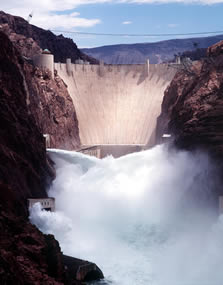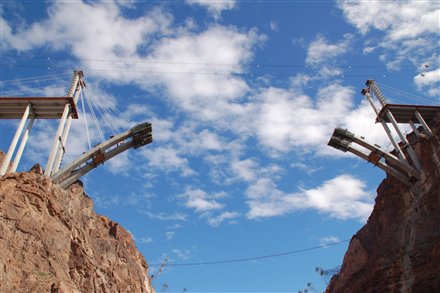
Ned Pelger's blog on construction, design and other weirdness. Email him at ned@constructionknowledge.net
Please help him win his readership competition against his son Lex at the Construction Phone Apps Blog
Construction of Hoover Dam began exactly 80 years ago today. At 726′ high and 1,244′ long, how thick do you think the dam is?
I read a This Day in History blurb that asked how long a two-lane concrete highway could be paved with the amount of concrete in Hoover Dam. Actually, the site asked if a highway started in New York, what city would it reach?
I’m embarrassed to say I thought an average of 72′ (three two-lane highways) might be right. At a 9″ concrete road thickness, that yields about 700 miles, so I guessed Atlanta. When I looked at the website to verify my guess, I was amazed to see the dam thickness to be 660′ at the base and 45′ at the top.
So a road could easily be paved to San Francisco.
As I searched for that answer, I learned a few things about President Herbert Hoover. He was geologist and mining engineer in California and then Australia. He married his college sweetheart from Stanford and they then moved to China, where he became one of the chief engineers. During the Boxer Rebellion, his wife worked in hospitals while he directed the building of barricades and he risked his life to save a group of Chinese children.
Hoover became bored making money and found a new calling as WWI began in 1914. He spent the next two years working 14 hour days helping distribute food and supplies to some 9M war victims. Hoover loved technology and efficient organization and used his skills in these areas to get the work done well. When the USA entered WWI in 1917, President Wilson appointed Hoover the head of the American Food Administration.
I particularly liked the following passage from the Hoover article:
“Hoover believed that, “food will win the war.” He established days to encourage people to not eat certain foods in order to save them for the soldiers: meatless Mondays, wheatless Wednesdays, and “when in doubt, eat potatoes.” These days helped conserve food for the war. He succeeded in cutting consumption of food needed overseas and avoided rationing at home (dubbed “Hooverizing” by government propagandists, although Hoover himself continually – and with little success – gave orders that publicity should not mention him by name, but rather should focus entirely on the Food Administration itself).”
The more I read about Hoover, the more I liked him. He pushed hard for Hoover Dam, being an engineer that understood the long-term benefits. He acquiesced to the naming of the dam after him, though didn’t much care when FDR had the named changed to Boulder Dam. Years later, an almost unanimous congressional vote changed the name back to Hoover Dam. To which Hoover replied, “I have never regarded the name as important. The important thing is a gigantic engineering accomplishment that will bring happiness to millions of people.”
So Happy Birthday Hoover Dam and congratulations Herbert Hoover for a life well lived. If you ever get a chance (by which I mean, try to make a chance), go tour the splendid Hoover Dam.
While TBW and I were in Las Vegas for the World of Concrete, we toured Hoover Dam. I’ve wanted to see it for years and was even more impressed than expected. The width of the dam was much less than I’d imagined, but the height astounded me. The design engineers found a perfect spot to build a dam, in a steep canyon with the Colorado River running through (as shown in the photo below):

Built during the Great Depression, many of the workers moved their families to the area for the duration of the project. Work was hard to find in those times and many more men applied than got hired.
Some of their jobs intrigued me. The High Scalers lowered down from the top of the cliffs in rope bosun’s chairs. These guys worked the rock faces of the cliffs, drilling, blasting and cleaning out shot rock. They would just bounce out of the way during the blast. This was the most dangerous and highest paying of the trades.
Our guide expressed amazement that anyone would take that much more risk for only a nominally higher pay. Knowing construction sites, though, this fact didn’t surprise me. The High Scalers were the stars of the project, the cool guys, what’s some extra danger in the face of that?
One of these High Scalers got tired of having guys work above him and accidentally drop rock pieces or tools down on him. He wore a baseball cap, but that didn’t cushion the hit too well. So he took his baseball cap and dipped it in pane tar, let it harden, dipped it again and repeated the process for a few days. Then he had a hard hat that did cushion the blows. Other guys saw how well this worked and made their own hard hats. Then the contracting company saw the value and had thousands of hard hats made. The hard hat has been found on job sites ever since.
Some other job titles amused me. Powder Monkeys were the men who handled dynamite, blasting caps and blasting powder. Grunts were electrician’s helpers.
Our tour guide told us that 96 men died on site during the construction of Hoover Dam. The contracting company had a contract agreement to pay death benefits for workers killed on site. The government generally did not require such a payment. Therefore, after any accident the company tried to get the worker into an ambulance and off site ASAP, because if they died enroute to a hospital, at the hospital, or any place offsite, the company no longer had to pay death benefits. There are no clear records for how many people died offsite.
You may have heard the legend that the bodies of several workers were left in Hoover Dam concrete pours. In fact, the concrete was all poured in 8″ lifts and left to cure, with the next pour being at another location. So no bodies were left in the dam. It would be like having a worker buried in concrete on a slab on grade floor pour.
While walking across the dam, we could see theHoover Dam Bypass project being built.The beauty of those two concrete spans extending out to each other makes me smile.

Since the 2001 terrorist attacks, Hoover Dam has been closed to large trucks and buses carrying luggage, so this bypass bridge will carry most of the traffic when completed.
Hoover Dam was built to provide water for California and the surrounding states (electrical power was almost an afterthought) and jobs for unemployed men during the Depression. Will our Stimulus Plan fund some grand projects that make America substantially more productive?